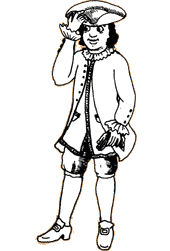The Plantation Community
Lesson Seven
TIME FOR A BALL!
READ AND DISCUSS
Pretend that it is the 18th century. A big party with dancing, called a ball, is being held at Gunston Hall. George and Ann Mason have invited all their friends from nearby plantations. You are a guest, too.
The ball will be a fancy occasion. You will be wearing your finest silk clothes. You'll be treated to a very large dinner with three courses in the Masons' elegant dining room. Then, everyone will move to the center hall of the house for dancing.
Do you know how to bow or curtsy? You will need to do this when you greet Mr. and Mrs. Mason at the ball. This is a sign of respect. Whole books have been written for young gentlemen and ladies like yourselves with instructions on how to walk, stand, bow, and curtsy properly. Let's look at sections from these books and learn how to do it right!
ACTIVITY 1
(if possible, done to 18th-century music)
Girls work in small groups to learn the curtsy. Boys work in small groups to learn the bow. Then, everyone gets together to share.
|
| "THE CURTSY" (girls)
1. "The Head must be erect [straight], the Shoulders drawn back, the Arms sideways [at your sides] ... not too close to the Body ...
2. The Hands [should be] placed a-cross [one on top of the other] not high or low [just below the waist] ... the Inside of the Hands should be opposed to [opposite] the Breast ...
3. Keep firm upon the Limbs [legs], then turn with ease, and look ... at the Person or Persons to whom the Complement [curtsy] is intended ...
4. Take a step sideways with either Foot and join the other to it ... [Put your heels together and your toes turned out.]
5. Let the Eyes [be] downcast ... while bending not too much [at the knees] ... you make the Courtsie properly; then rising from it gradually raise the Eyes ..." |

|
| "THE BOW" (boys)
Boys must act out that they are wearing a three-cornered hat and holding a glove.
1. "The Person must be erect [standing straight] ... The right Arm must rise to the Hat with moderate Motion ... [Boys should pretend to reach for a hat by slowly moving their arm in front of their bodies.]
2. The Wrist must be strait [straight] ... the Fingers must be on the Brim, and the Forefinger extended on the crown [top] of the Hat ...
3. Whilst taking it [the hat] off, let the Look and Action be complaisantly address'd to the Person to whom the Complement is intended ... [Boys should look in a friendly way toward the person to whom they are bowing.]
4. The left Arm should fall ... gently by the side ... Holding the Glove in an easy ... manner ...
5. Then being firm on the left Leg [standing straight], the right will ... advance [move forward] and make the Bow on the right ..." [Boys bend from the waist.]
|
 
|
From The Rudiments of Genteel Behavior, by Francois Nivelon, 1737.
ACTIVITY 2
(if possible, done to 18th-century music)
Next, you have to practice your dancing. The dances have unusual names like minuet and saraband. But you're not ready to try these yet. Your dancing master says that the first step to dancing well is to learn the correct way to stand, walk, and hold your head. There are five positions just for standing!
As a class, practice the five "proper positions of the feet" (next page). Remember these rules for 18th-century ladies and gentlemen:
|
1ST POSITION: The
heels of the two feet are
close together, so that they
touch; the toes being
turned out.
|
|
2ND: The two feet are open,
in the same line, so that the
distance between the two
heels, is precisely the length
of one foot.
|
|
3RD: The heel of one foot is
brought to the ankle of the
other, or seems to lock in
with it.
|
|
4TH: The two feet are the
one before the other, a foot's
length distance between the
two heels, which are on the
same line.
|
|
5TH: The two feet are
across the one before the
other, so that the heel of one
foot is directly opposite to
the toes of the other.
|
|
| From Critical Observations on the Art of Dancing, by Giovanni Andrea Gallini, 1770.
MORE
1. Give an oral report on 18th-century composers from Great Britain and Europe. Possible com-posers: John Britain, Joseph Hadyn, George Frederick Handel, Henry Purcell.
2. Explore clothing worn in America during the 1700s. What was worn to a ball? What would you feel like wearing a long dress, stays, or breeches?
3. Pretend that you were George Mason's guest at a ball at Gunston Hall. Write a letter to a friend to describe what took place.
  |






